A LONGER-TERM STUDY OF WHAT HAPPENS WHEN COMMITMENT CONTRACTS EXPIRE
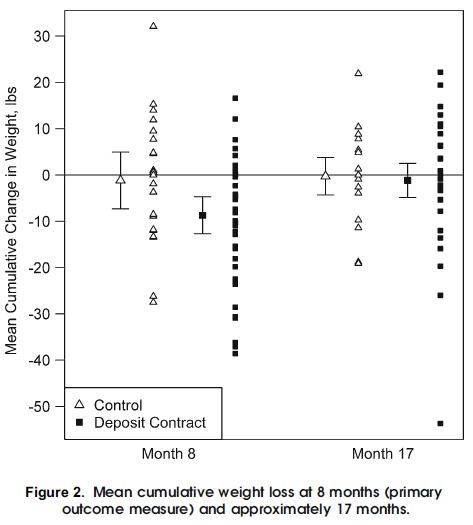
A popular kind of commitment device is betting that you’ll lose weight.
At Decision Science News, we love the commitment devices. But, as we’ve have spoken about, we have mixed feelings about them, including the nagging concern that commitment devices may not lead to deep-seated changes or habit formation.
When the commitment device is gone, do the good habits remain?
This week, we got some empirical evidence on that question. We were down at Penn, attending the Annual Symposium put on by the Penn CMU Roybal P30 Center in Behavioral Economics and Health, and Leslie John and colleagues presented a longer-run study spanning an eight month period during which a commitment contract was in place, and a follow-up period of 9 months. As the figure above shows, at Month 8 the devices worked: People lost about 10 pounds
But what happened when the commitment devices expired? When all bets were off, all the weight was regained (Month 17 in the figure above).
This is the first study we know of that looks at the longer-term consequences of commitment contracts. It’s hard to generalize from one study, but we think it shows that if you want a commitment device to work, you simply can’t let it drop. You have to keep renewing. So, if commitment devices are going to help folks, we need to find ways to get people to renew them. Or seek deep-seated changes so that people will do the right thing even when the device is absent.
REFERENCE
Leslie K. John, George Loewenstein, Andrea B. Troxel, Laurie Norton, Jennifer E. Fassbender, and Kevin G. Volpp. (2011). Financial Incentives for Extended Weight Loss: A Randomized, Controlled Trial. Journal of General Internal Medicine. DOI: 10.1007/s11606-010-1628-y
ADDENDUM
Reader Alex V writes in with another experiment of this type, and one that does find longer run effects (at 12 months). We wonder if it is easier to stay off cigarettes than to stay off food. That is, quitting smoking is *very* hard, but once one has crossed over, perhaps it is easier not to relapse.
Put Your Money Where Your Butt Is: A Commitment Contract for Smoking Cessation
American Economic Journal: Applied Economics, 2(4): 213-35, October 2010, with Xavier Gine and Dean Karlan.
This paper tested a voluntary commitment product (CARES) for smoking cessation, where smokers were offered a savings account in which they deposit funds for 6 months, after which they take urine tests for nicotine and cotinine. If they pass, the money is returned; otherwise it is forfeited. 11% of smokers offered CARES take it up, and smokers randomly offered CARES were 3% more likely to pass a 6-month test than the control group.
The effect persists in surprise tests at 12-months. So this is just one more paper that looks at the longer-term effects of commitment contracts! (albeit not that far into the future).
IS THE HOT HAND SPORT SPECIFIC?
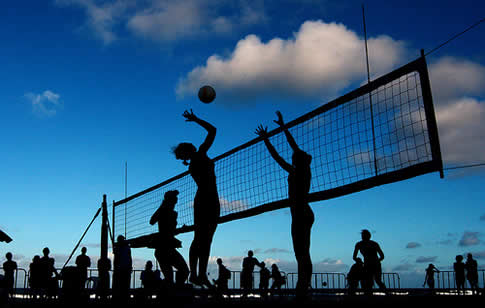
Belief in the hot hand in sports is the belief that someone who makes a shot has an increased probability of making the next shot (above what his or her long run stats would suggest), and that someone who misses a shot has a decreased probability of making the next shot (below what his or her long run stats would suggest).
There is much debate about the hot hand effect. The Wikipedia article on the topic calls it the hot hand fallacy, and the debate is whether it is really a fallacy. What if, in certain sports, there really are times when players are hot or cold relative to their long run averages? Belief in the hot hand would be sensible.
There is much written on the topic. JDMer Alan Reifman has a hot hand website and a hot hand book: Hot Hand: The Statistics Behind Sports’ Greatest Streaks
In a recent paper, Markus Raab et al. claim there is evidence of the hot hand in volleyball, and that it’s not a fallacy to believe in it there. According to Wikipedia, many in volleyball believe in and act on the hot hand effect. Alan Reifman has commented on it the Raab article here, with some suggested minor improvements.
Here’s the paper’s reference and abstract.
REFERENCE Raab, M., Gula, B. & Gigerenzer, G. (2011). The Hot Hand Exists in Volleyball and Is Used for Allocation Decisions. Journal of Experimental Psychology: Applied, 18 (1), 81-94. [Download]
ABSTRACT
The “hot hand” belief in sports refers to the conviction that a player has a higher chance of making a shot after two or three successful shots than after two or three misses (resulting in “streaks”). This belief is usually considered a cognitive fallacy, although it has been conjectured that in basketball the defense will attack a “hot” player and prevent streaks from occurring. To address this argument, we provide the first study on the hot hand in volleyball, where the net limits direct defensive counterstrategies, meaning that streaks can more likely emerge if a player is hot. We first establish that athletes believe in the hot hand in volleyball (Study 1A). Analyzing the top 26 first-division players, we then show that streaks do exist for half of the players (Study 1B). Coaches can detect players’ performance variability and use it to make strategic decisions (Study 2A). Playmakers are also sensitive to streaks and rely on them when deciding to whom to allocate the ball (Study 2B). We conclude that for volleyball the hot hand exists, coaches and playmakers are able to detect it, and playmakers tend to use it “adaptively,” which results in more hits for a team.
SEE ALSO
Gilovich, Thomas; Tversky, A. & Vallone, R. (1985). “The Hot Hand in Basketball: On the Misperception of Random Sequences”. Cognitive Psychology 3 (17), 295–314
Photo credit:http://www.flickr.com/photos/spasmoid/2224941051/
Filed in
Ideas
 Subscribe
Subscribe to Decision Science News by Email (one email per week, easy unsubscribe)
CHANGING YOUR WEIGHT BY CHANGING THE ENVIRONMENT

One of Decision Science News’ rules of thumb for losing weight was never eat more than 500 calories at at time.
In Japan(*), they have institutionalized this at the Tanita Shokudo restaurant, which serves a daily 500 calorie meal.
We at DSN believe this will work, as we’ve seen our own weights decrease after moving to small-portion-size countries and increase after moving back to the States. We admit to following a simple heuristic of “eat what you get till it’s gone”.
(*) BTW, we’ve noticed that people pay more attention when you preface things with “In Japan, …”.
Filed in
Books
 Subscribe
Subscribe to Decision Science News by Email (one email per week, easy unsubscribe)
INTELLIGENCE IN THE WORLD
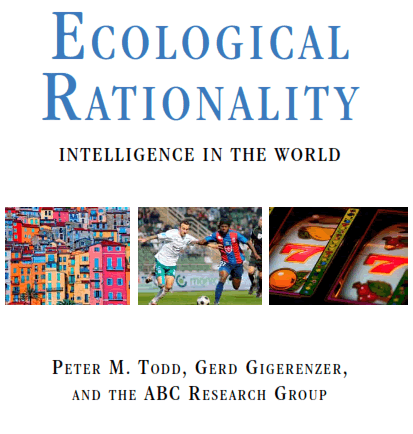
Ecological Rationality: Intelligence in the World is a new book by Peter Todd, Gerd Gigerenzer and the ABC Research Group (including your Decision Science News editor). It is much of the same team who brought you Simple Heuristics That Make Us Smart , with a number of new voices in the mix.
, with a number of new voices in the mix.
Here is a blurb:
Ecological Rationality: Intelligence in the World explores how people can be effective decision makers by using simple heuristics that fit well into the structure of the environment. When we wield the right tool from the mind’s adaptive toolbox for a particular situation, we can make good choices with little information or computation. Thus, simple strategies excel by exploiting the reliable patterns in the world. Heuristics are not good or bad, “biased” or “unbiased,” on their own, but only in relation to the setting in which they are used. The authors demonstrate this principle through case studies of heuristics and environments fitting together to produce good decisions, in situations including sports competitions, the search for a parking space, business group meetings, and doctor/patient interactions. The message of Ecological Rationality is to study mind and environment in tandem. Intelligence is not only in the mind but also in the world, captured in the structures of information around us.
The interdisciplinary research presented in this book, by turns theoretical, empirical, and applied, will be interesting and inspiring for all those concerned with how people make decisions. With specific examples in a variety of domains, it shows psychologists, economists, philosophers, cognitive scientists, and ethologists how to study the mind together with the decision environment, and the perils of ignoring their vital interaction. Furthermore, this book provides guidance to practitioners who aim to design environments and institutions that help people make better choices.
Filed in
Conferences
 Subscribe
Subscribe to Decision Science News by Email (one email per week, easy unsubscribe)
GEORGE LOEWENSTEIN AND COLIN CAMERER KEYNOTE SPEAKERS

TIBER, the Tilburg Institute for Behavioral Economics Research is happy to announce the 11 Tiber Symposium on Psychology and Economics, to be held on August 24, 2012.
The symposium aims to bring together Economists, Psychologists, Marketing researchers and others who work on Behavioral Decision Making, either in individual or interdependent settings. The symposium will be held at Tilburg th University and consists of two keynotes, a number of parallel sessions with presentations of about 20 to 30 minutes, and a poster session.
This year’s keynote speakers are:
– George Loewenstein
– Colin Camerer
The goal of this series of symposia is to establish contact and discussion between researchers of the different fields. We look for empirical contributions from diverse fields, such as Individual Decision Making, Consumer Behavior, Bargaining, Social Dilemmas, Experimental Games, Emotions, Fairness and Justice, Rational Choice, and related subjects.
CALL FOR PAPERS
If you would like to contribute to this symposium by presenting a paper, we ask you to send an abstract of max. 300 words via email to Diana Vingerhoets (D.Vingerhoets@tilburguniversity.edu). Please use subject: TIBER XI in your email.
On the basis of these abstracts we will select presenters for the symposium. Please indicate whether you would be willing to present your research in a poster session by adding Poster: Yes or Poster: No to your submission.
IMPORTANT DATES
18th of April Call for papers
1st of June Deadline for submission of abstracts
18th of June Selection of speakers
11th of August Normal registration deadline (late registration fee applies after this date)
24th of August Symposium at Tilburg University
More information about the program of the symposium and the keynote speakers, as well as the location of the symposium and the registration forms will soon be available here.
If you have any questions regarding the conference, please contact Job van Wolferen (J.vanWolferen@tilburguniversity.edu). Again, please use subject: TIBER XI. Other organizers include Ilja van Beest, Rik Pieters, Jan Potters, and Marcel Zeelenberg.
FAMILIARITY-LIKING EFFECTS VIA CAPTCHAS
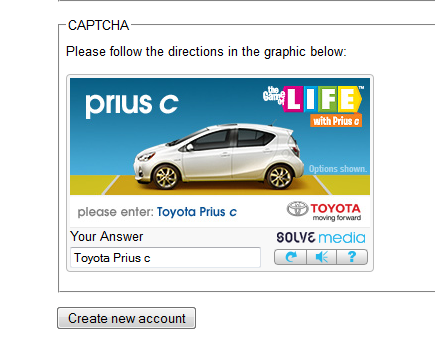
Decision Science News was creating a new account online and had to fill out the above-pictured CAPTCHA (*) to proceed. It’s an ad and a CAPTCHA in one. It gets people to spend time and effort typing the name of the brand. [If you don’t know what a CAPTCHA is see Wikipedia, or the Official CAPTCHA Site]
That time and effort should serve the advertiser well.
Cognitive psychologists know that the longer people spend processing a thing the more likely they are to remember it. By getting you to type the name of the brand, you become more likely to remember it, which is what advertisers want.
But this manipulation does double duty. Psychologists have also uncovered the familiarity-liking effect in which repeated stimuli (e.g. songs) become liked simply for being familiar. These studies randomly assign people to various stimuli, repeat the stimuli over time, and measure liking, which tends to increase. Each subsequent impression of an ad has this effect on you, but some ad impressions go unnoticed. By getting you to type the name of the brand, you are pretty sure to notice it. [Another thing that determines whether people notice ads is the amount of time they are in view, see our recent papers on this here and here].
What’s next? Will they go after the frequency-validity effect, by which familiar statements are judged as more likely to be true? If so, the CAPTCHAs of the future will ask you to type things like “I’m going to buy a Prius C right away!”
REFERENCES
Arkes, H. R., Hackett, C. and Boehm, L. (1989), The generality of the relation between familiarity and judged validity. Journal of Behavioral Decision Making, 2, 81–94.
Bornstein, Robert F. (1989) Exposure and affect: Overview and meta-analysis of research, 1968–1987. Psychological Bulletin, 106(2), 265-289.
Hintzman, Douglas L. and Richard A. Block (1971). Retition and memory: Evidence for a multiple-trace hypothesis. Journal of Experimental Psychology, 88(3), 297-306.
(*) One of the inventors of the CAPTCHA (the original one, not this manipulative version) is John Langford, a colleague of mine at Yahoo Research.
Filed in
Ideas
 Subscribe
Subscribe to Decision Science News by Email (one email per week, easy unsubscribe)
STRANGE WORD IN FRONT PAGE HEADLINES OF TWO NATIONAL NEWSPAPERS ON SAME DAY
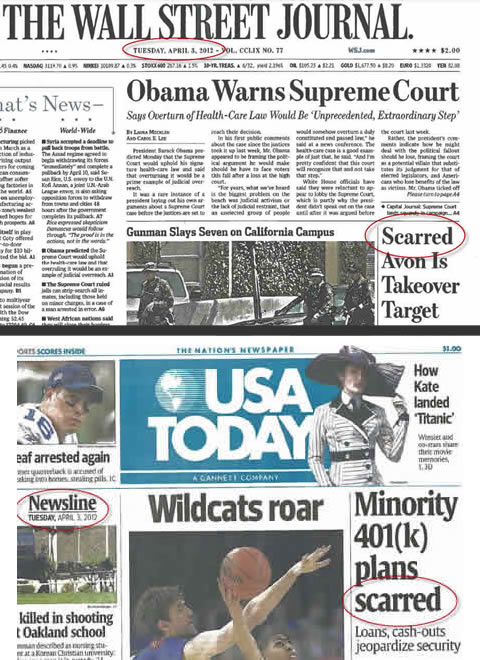
A friend of Decision Science News awoke in a hotel on April 3rd of this year and found two newspapers outside the door. The Wall Street Journal used the word “scarred” in its front page headline, which was weird enough, but all was made far weirder by the USA Today, which used the same word, also in a front page headline, also above the fold, on the same day.
We could overfit and say that “scarred” is the hot buzzword of 2012, or underfit and act as though there’s nothing to this at all, but instead we’ll just put it out there.
Scarred. Consider it out there.
SOCIETY FOR JUDGMENT AND DECISION MAKING NEWSLETTER

Just a reminder that the quarterly Society for Judgment and Decision Making newsletter can be downloaded from the SJDM site:
http://sjdm.org/newsletters/
It features jobs, conferences, announcements, and more.
Enjoy!
Decision Science News / SJDM Newsletter Editor
GLOBAL WEATHER DATA SUPERIMPOSED ON MAPS
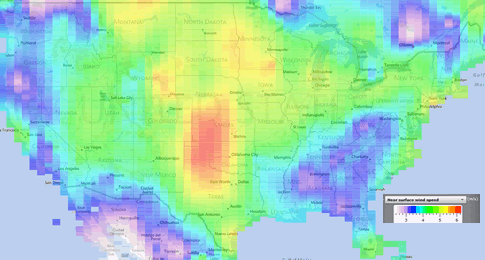
At DSN, we’ve been playing a bit with FetchClimate Explorer from Microsoft Research. It lets one define regions of the globe over which it superimposes spatial and time series data concerning temperature, precipitation, sunlight, and, pictured above, wind speed.
See a demo of FetchClimate in this video, starting at 22:45.
The data (graphed above, larger image here) mesh with our experience living in Chicago that the “windy city” is not really that windy. Yes, Chicago is in a part of the country that is windier than average, but Kansas makes it look calm. Furthermore, New York City and Long Island are windier than Chicago, but nobody goes “OMG! How can you stand that wind?” when you say that you live there.
Average Wind Speed (meters / second)
- Chicago 4.92
- New York, NY 5.01
- Milwaukee, WI 5.03
- Casper, WY 5.5
- Rochester, MN 5.5
- Amarillo, TX 6.12
- Dodge City, KS 6.25
And a little wind is a good thing. Houston, TX (wind speed 4.11 m/s) would love a bit of air movement during its stifling summers. They say the phrase “windy city” has not to do with high winds or the hot air of politicians, but rather stems from an Chicago tourism slogan promoting the delightful summer breezes in the days before air conditioning.
 Subscribe to Decision Science News by Email (one email per week, easy unsubscribe)
Subscribe to Decision Science News by Email (one email per week, easy unsubscribe)











